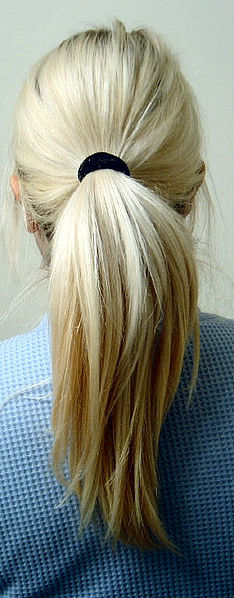Physicists Explain the Shape of Perfect Ponytails

Every schoolboy has, at some point, contemplated the fountain-like springiness of the ponytail attached to the girl sitting in front of him. Five centuries ago, even Leonardo da Vinci mused about the fluid quality of hair, which streams from the head like water.
Now, ponytails have been subjected to the fine-toothed comb of science. In a paper published Feb. 13 in the journal Physical Review Letters, physicists in the United Kingdom derived a "ponytail shape equation" — a mathematical formula that accounts for the stiffness of the hair in a given ponytail, its weight and its average curliness in order to predict that ponytail's shape.
The "fourth order non-linear differential equation," as study co-author Robin Ball, a physicist at the University of Warwick, described the ponytail formula, "is a three-way balance of bending, gravity and curliness."
As gravity pulls a bundle of hair downward, collisions between the individual hairs cause the tail to swell outward, Ball explained — and the curlier the hair, the more internal collisions and thus the greater the "swelling pressure." These forces combine to determine how fan-like or pointy-at-the-bottom a given ponytail will be.
"The test was whether the shape was predicted correctly," Ball told Life's Little Mysteries. The researchers compared their theoretical model with actual ponytails by measuring the properties of "hair switches," bundles of human hair that are used for research by hair product companies. They found a close agreement between the ponytails' actual and predicted shapes.
Among their findings is that, regardless of a ponytail's length, its "launch angle" — the angle at which the outermost hairs emerge from the hair tie — is remarkably consistent at 17 degrees from the vertical.
As well as solving the longstanding ponytail puzzle, the new research helps unravel the structure of other fibrous materials, such as wool and fur. It could also impact the computer animation industry, where the lifelike representation of hair has been a challenge. [Why CGI Humans Are Creepy, and What Scientists Are Doing about It]
Get the world’s most fascinating discoveries delivered straight to your inbox.
But the researchers believe their research is interesting purely from a theoretical standpoint, too. As lead author Raymond Goldstein of Cambridge University told Reuters, the work shows how the tools of statistical physics "can be used to solve a problem that has puzzled scientists and artists ever since Leonardo da Vinci remarked on the fluid-like streamlines of hair in his notebooks 500 years ago."
Follow Natalie Wolchover on Twitter @nattyover. Follow Life's Little Mysteries on Twitter @llmysteries, then join us on Facebook.
Natalie Wolchover was a staff writer for Live Science from 2010 to 2012 and is currently a senior physics writer and editor for Quanta Magazine. She holds a bachelor's degree in physics from Tufts University and has studied physics at the University of California, Berkeley. Along with the staff of Quanta, Wolchover won the 2022 Pulitzer Prize for explanatory writing for her work on the building of the James Webb Space Telescope. Her work has also appeared in the The Best American Science and Nature Writing and The Best Writing on Mathematics, Nature, The New Yorker and Popular Science. She was the 2016 winner of the Evert Clark/Seth Payne Award, an annual prize for young science journalists, as well as the winner of the 2017 Science Communication Award for the American Institute of Physics.
 Live Science Plus
Live Science Plus






